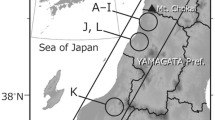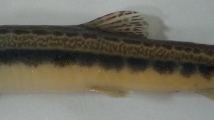Abstract
Gymnodiptychus integrigymnatus is a critically endangered species endemic to the Gaoligongshan Mountains. It was thought to be only distributed in several headwater-streams of the Longchuanjiang River (west slope of the Gaoligongshan Mountains, belonging to the Irrawaddy River drainage). In recent years, dozens of G. integrigymnatus specimens have been collected in some streams on the east slope of the Gaoligongshan Mountains (the Salween drainage). We performed a morphological and genetic analyses (based on cytochrome b and D-loop) of the newly discovered populations of G. integrigymnatus to determine whether the degree of separation of these populations warrants species status. Our analysis from the cytochrome b gene revealed that nine individuals from the Irrawaddy drainage area and seven individuals from the Salween drainage area each have only one unique haplotype. The genetic distance between the two haplotypes is 1.97%. Our phylogenetic analysis revealed that G. integrigymnatus is closely related to highly specialized schizothoracine fishes. Analysis from the mitochondrial control region revealed that G. integrigymnatus has relatively high genetic diversity (π was 0.00891 and h was 0.8714), and individuals from different river drainages do not share the same haplotypes. The AMOVA results indicated 87.27% genetic variability between the Salween and Irrawaddy populations. Phylogenetic trees show two major geographic groups corresponding to the river systems. We recommend that G. integrigymnatus should be considered as a high priority for protected species status in the Gaoligongshan Mountains National Nature Reserve, and that the area of the Gaoligongshan Mountains National Nature Reserve should be expanded to cover the entire distribution of G. integrigymnatus. Populations of G. integrigymnatus from different river systems should be treated as evolutionarily significant units.




Similar content being viewed by others
References
Aquadro CF, Greenberg BD (1983) Human mitochondrial DNA variation and evolution: Analysis of nucleotides sequences from seven individuals. Genetics 103:287–312
Cao WX, Chen YY, Wu YF, Zhu SQ (1981) Origin and evolution of schizothoracinae fishes in relation to the upheaval of the Xizang Plateau. In: The Team of the Comprehensive Scientific Expedition to the Qinghai-Xizang Plateau, Chinese Academy of Sciences (ed) Collection in Studies on the Period, Amplitude and Type of the Uplift of the Qinghai-Xizang Plateau. Science Press, Beijing, pp 118–130
Chen YF, Huang SY (1998) Schizothoracinae. In: Chen YY (ed) The Fishes of the Hengduan Mountains Region. Science Press, Beijing, pp 183–245
Chen YF, Cao WX (2000) Schizothoracinae. In: Yue PQ (ed) Fauna Sinica Osteichthyes Cypriniformes III. Science Press, Beijing, pp 273–390
Chen ZM, Chen YF (2001) Phylogeny of the specialized schizothoracine fishes (Teleostei: Cypriniformes: Cyprinidae). Zool Stud 40:147–157
Chu XL, Chen YR (1989) The fishes of Yunnan. Science Press, Beijing, Part I Cyprinidae
Mo TP (1989) Schizothoracinae. In: Chu XL, Chen YR (eds) The fishes of Yunnan. Part I Cyprinidae. Science Press, Beijing, China, pp 286–321
Excoffier L, Smouse PE, Quattro JM (1992) Analysis of molecular variance inferred from metric distances among DNA haplotypes–application to human mitochondrial DNA restriction data. Genetics 131:479–491
Felsenstein JP (1985) Confidence limits on phylogenies: an approach using the bootstrap. Evolution 39:783–791
Garner KJ, Ryder OA (1996) Mitochondrial DNA diversity in Gorillas. Mol Phylogenet Evol 6:39–48. doi:10.1006/mpev.1996.0056
He DK, Chen YF, Chen YY, Chen ZM (2004) Molecular phylogeny of the specialized schizothoracine fishes (Teleostei: Cyprinidae), with their implications for the uplift of the Qinghai-Tibetan Plateau. Chinese Sci Bull 49:39–48. doi:1001360/03we0212
He DK, Chen YF (2006) Biogeography and molecular phylogeny of the genus Schizothorax (Teleostei: Cyprinidae) in China inferred from cytochrome b sequences. J Biogeogr 33:1448–1460. doi:10.1111/j.1365-2699.2006.015510.x
He DK, Chen YF (2007) Molecular phylogeny and biogeography of the highly specialized grade schizothoracine fishes (Teleostei: Cyprinidae) inferred from cytochrome b sequences. Chinese Sci Bull 52:777–788. doi:10.1007/s11434-007-0123-2
Hu J, Fang SG, Wan QH (2006) Genetic diversity of Chinese water deer (Hydropotes inermis inermis): implications for conservation. Biochem Genet 44:156–167. doi:10.1007/s10528-006-9020-7
Kimura M (1980) A simple method for estimating evolutionary rate of base substitutions through comparative studies of nucleotide sequences. J Mol Evol 16:111–120
Kumar S, Tamura K, Nei M (2004) MEGA3: Integrated software for Molecular Evolutionary Genetics Analysis and sequence alignment. Bioinformatics 5:150–163. doi:10.1093/bib/5.2.150
Li Y, Wang DQ, Fang YL, Liu SP, Duan XB, Chang YH, Chen DQ (2007) Genetic diversity in the bronze gudgeon, Coreius heterodon, from the Yangtze River system based on mtDNA sequences of the control region. Environ Biol Fish 82:35–40. doi:10.1007/s10641-007-9248-z
Liu HZ, Tzeng CS, Teng HY (2002) Sequence variations in the mitochondrial DNA control region and their implications for the phylogeny of the Cypriniformes. Can J Zool 80:569–581. doi:10.1139/Z02-035
Myers N, Russell AM, Cristina GM, da Fonseca Gustavo AB, Jennifer K (2000) Biodiversity hotspots for conservation priorities. Nature 403:853–858, doi:10.1038/35002501
Qi DL, Li TP, Zhao XQ, Guo SC, Li JX (2006) Mitochondrial cytochrome b sequence variance and phylogenetics of highly specialized Schizothoracine fishes (Teleostei: Cyprinidae) in the Qinghai-Tibet plateau. Biochem genet 44:270–285. doi:10.1007/s10528-006-9022-5
Quattro JM, Greig TW, Coykendall DK, Bowen BW, Baldwin JD (2002) Genetic issues in aquatic species management: the shortnose sturgeon (Acipenser breviostrum) in the southeastern United States. Conserv Genet 3:155–166. doi:10.1023/A:1015275602748
Rozas J, Sânchez-DelBarrio Messeguer JC, Rozas R (2003) DnaSP, DNA polymorphism analyses by the coalescent and other methods. Bioinformatics 19:2496–2497. doi:10.1093/bioinformatics/btg359
Sambrook J, Fritsch EF, Maniatis T (1989) Molecular cloning: A laboratory manual. Cold Spring Harbor Laboratory Press, New York
Schneider S, Roessli D, Excoffier L (2000) Arlequin ver. 2.000: A software for population genetics data analysis. Genetics and Biometry Laboratory, University of Geneva, Switzerland.
Song ZB, Song Jun, Yue BS (2008) Population genetic diversity of Prenant’s schizothoracin, Schizothorax prenanti, inferred from the mitochondrial DNA control region. Environ Biol of Fish 81:247–252, doi:10.1007/s10641-007-9197-6
Swofford DL (2003) PAUP*: Phylogenetic Analysis Using Parsimony (*and other methods), Version 4.0b10. Sinauer Associates, Sunderland, MA
Wang S, Xie Yan (2004) China Species Red List Vol. I Red List. pp 162–163. Higher Education Press, Beijing, China
Wu YF, Wu CZ (1991) The Fishes of the Qinghai-Xizang Plateau. Sichuan Publishing House of Science & Technology, Chengdu
Wu H, Wang QH, Fang SG (2004) Two genetically distinct units of the Chinese sika derr (Cervus nippon): analyses of mitochondrial DNA variation. Biol Conserv 119:183–190. doi:10.1016/j.biocon.2003.10.027
Wu HL, Fang SG (2005) MtDNA genetic diversity of black muntjac (Muntiacus crinifrons): An endangered species endemic to China. Biochem genet 43:407–416. doi:10.1007/s10528-005-6779-x
Xiao H, Chen SY, Liu ZM, Zhang RD, Li WX, Zan RG, Zhang YP (2005) Molecular phylogeny of Sinocyclocheilus (Cypriniformes: Cyprinidae) inferred from mitochondrial DNA sequences. Mol Phylogenet Evol 36:67–77. doi:10.1016/j.ympev.2004.12.007
Xiao WH, Zhang YP, Liu HZ (2001) Molecular systematics of Xenocyprinae (Teleostei: Cyprinidae): taxonomy, biogeography, and coevolution of a special group restricted in East Asia. Mol Phylogenet Evol 18:63–173. doi:10.1006/mpev.2000.0879
Zhang B, Fang SG, Xi YM (2004) Low genetic diversity in the endangered crested ibis Nipponia nippon and implications for conservation. Bird Conserv Int 14:183–190. doi:10.1017/S0959270904000231
Zhao K, Li JB, Yang GS, Duan ZY, He SP, Chen YY (2005) Molecular phylogenetics of Gymnocypris (Teleostei: Cyprinidae) in Lake Qinghai and adjacent drainages. Chinese Sci Bull 50:1325–1333. doi:10.1360/982005-223
Acknowledgements
We are grateful to Dave Neely, David Catania, William Poly of the California Academy of Sciences, and to Huang Yanfei, Min Rui, and Wu Fei of the Kunming Institute of Zoology (KIZ), The Chinese Academy of Sciences, for their help in collecting and other aspects of this study. We thank Jia Li (KIZ) for her kindly and patient help on the laboratory works. We thank Kevin W. Conway, Saint Louis University, USA, and two anonymous reviews for their critically reviewing the manuscript. This work was supported by National Natural Science Foundation of China (30730017), National Science Foundation (USA) (DEB-0103795) and National Basic Research Program of China (2007CB411600).
Author information
Authors and Affiliations
Corresponding authors
Appendices
Appendix 1. Schizothoracinae species (GenBank accession number) of cytochrome b used for phylogenetic analysis
Schizothorax waltoni (AY463518), Schizothorax prenanti (AY954260), Schizothorax wangchiachii (AY463521), Diptychus maculatus (FJ931475), Ptychobarbus kaznakovi (EF533723), Ptychobarbus chungtienensis (AY463507), Ptychobarbus conirostris (AY463509), Ptychobarbus dipogon (AY463510), Gymnodiptychus pachycheilus (DQ491113), Gymnodiptychus pachycheilus (DQ646883), Gymnodiptychus dybowskii (AY463513), Gymnodiptychus dybowskii (EF533724), Gymnodiptychus integrigymnatus (AY463526), Gymnodiptychus integrigymnatus (AY463527), Gymnodiptychus integrigymnatus (FJ534420), Gymnocypris przewalskii (FJ494961), Gymnocypris eckloni (FJ534403), Gymnocypris namensis (DQ309353), Oxygymnocypris stewartii (DQ491114), Schizopygopsis younghusbandi (DQ646895), Schizopygopsis pylzovi (DQ491188), Schizopygopsis thermalis (DQ309367), Chuanchia labiosa (AY608650), Chuanchia labiosa (AY608651), Platypharodon extremus (AY608657), Platypharodon extremus (AY608658), Herzensteinia microcephalus (DQ309357).
Appendix 2. Morphological characters measured in this study
Standard length (SL), head length (HL), caudal-peduncle length (CL), caudal-peduncle depth (CD), snout length (SN), eye diameter (ED), interorbital width (IOW), mouth width (MW), body depth (BD), Head depth (HD), head width (HW), dorsal-fin base length (DL), predorsal length (PDL), prepectoral length (PPL), prepelvic length (PVL), preanal length (PAL), distance between pectoral-fin origin and pelvic-fin origin (POVO), distance between pectoral-fin origin and anal-fin origin (POAO), distance between pelvic-fin origin to anal-fin origin (VOAO), distance between anal-fin origin between base of caudal-peduncle (AOC), length of the second branched dorsal-fin ray (LSBDR), pectoral-fin length (PL), pelvic-fin length (VL), anal-fin length (AL), distance between snout and end of occipital (SNEO), distance between snout and dorsal-fin origin (SNDO), distance between snout to pectoral-fin origin (SNPO), distance between pectoral-fin origin and dorsal-fin origin (PODO), distance between pectoral-fin origin and end of dorsal-fin base (POEDB), distance between pelvic-fin origin and end of occipital (VOEO), distance between pelvic-fin origin and dorsal-fin origin (VODO), distance between pelvic-fin origin and end of dorsal-fin base (VOEDB), distance between anal-fin origin to end of occipital (AOEO), distance between anal-fin origin and dorsal-fin origin (AODO), distance between anal-fin origin and end of dorsal-fin base (AOED), distance between anal-fin origin and dorsal point at the caudal-peduncle (AODC), distance between anal-fin origin and pectoral point at the caudal peduncle (AOPC).
Rights and permissions
About this article
Cite this article
Yang, J., Chen, X. & Yang, J. Molecular and morphological analysis of endangered species Gymnodiptychus integrigymnatus (Teleostei: Cyprinidae). Environ Biol Fish 88, 189–199 (2010). https://doi.org/10.1007/s10641-010-9629-6
Received:
Accepted:
Published:
Issue Date:
DOI: https://doi.org/10.1007/s10641-010-9629-6




